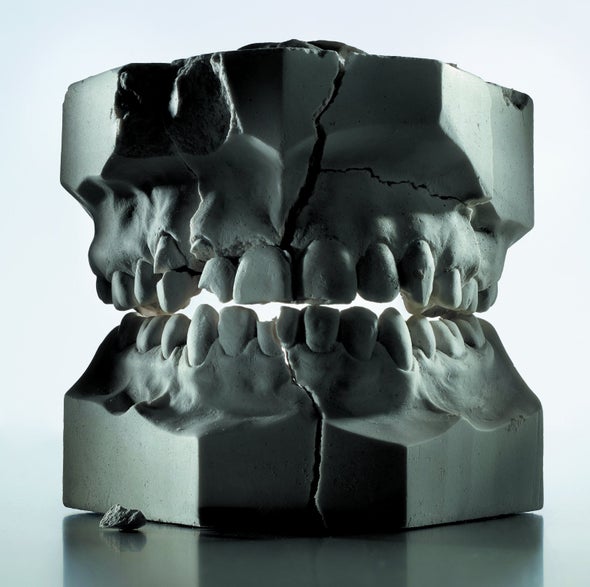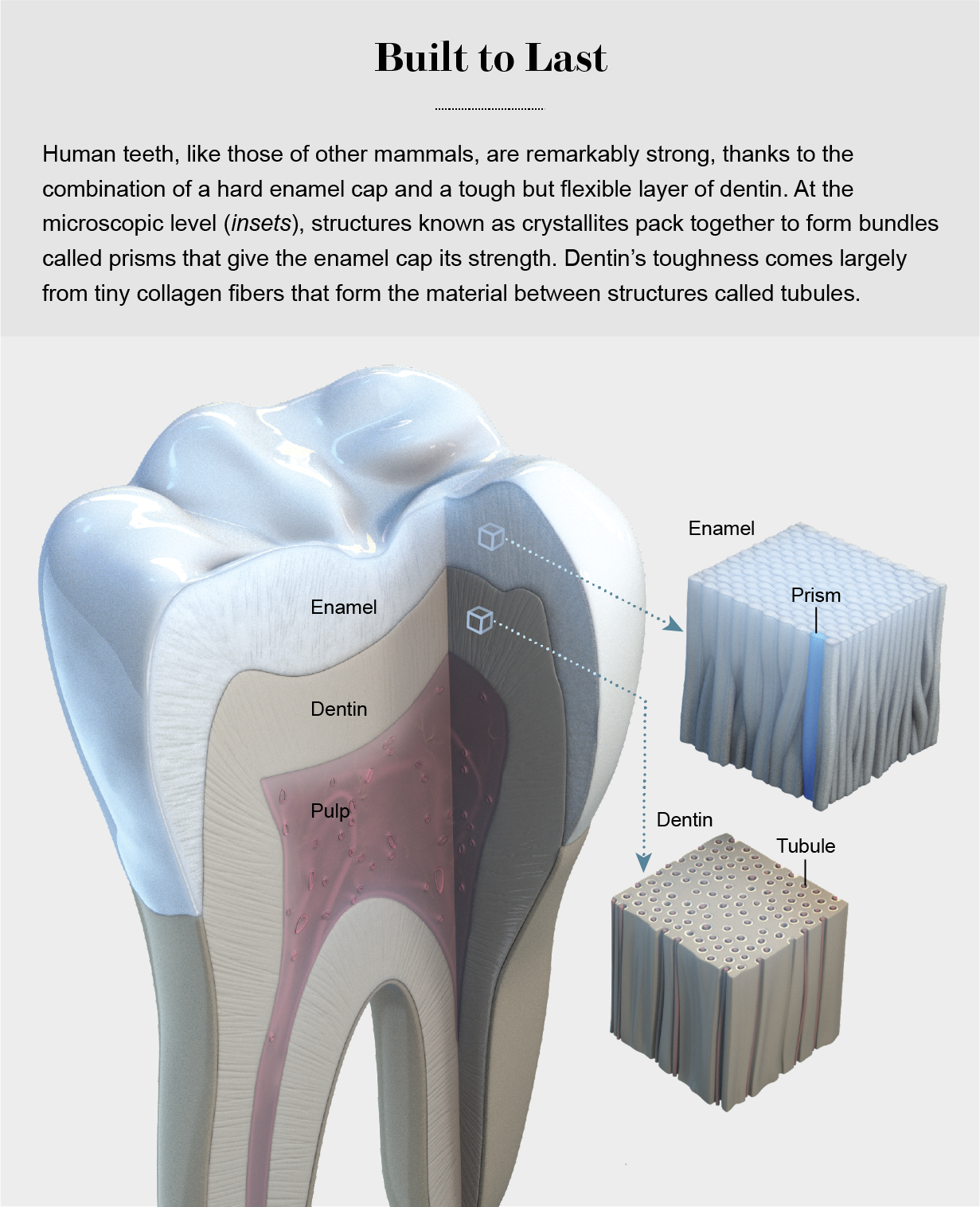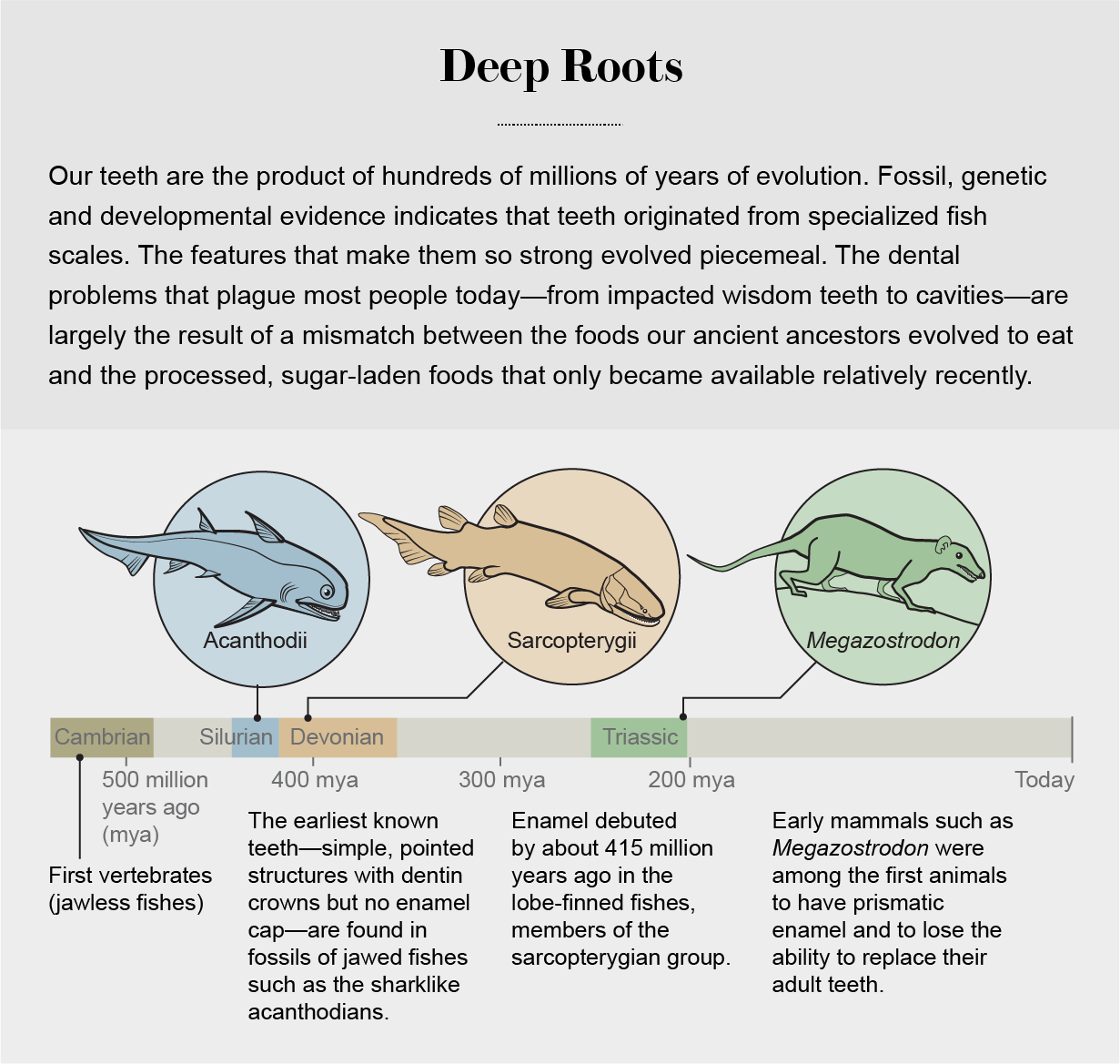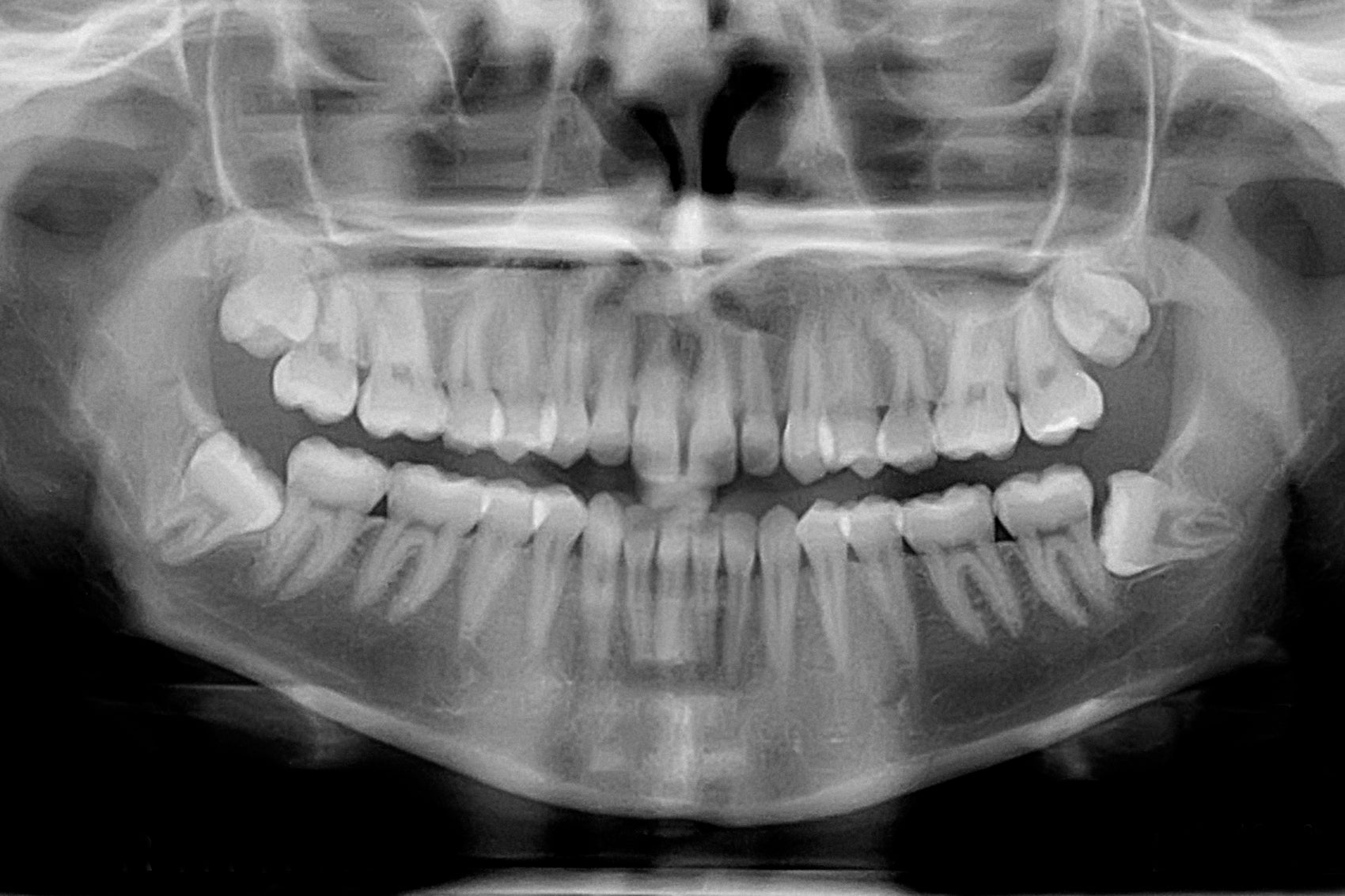Our choppers are crowded, crooked and riddled with cavities. It hasn’t always been this way

Credit: Adam Voorhes Gallery Stock
Dental problems such as crowding and cavities are common in people today. But other species tend not to have such afflictions, nor did our fossil forebears.
Our teeth have evolved over hundreds of millions of years to be incredibly strong and to align precisely for efficient chewing. They developed these characteristics to function in a specific oral environment.
Our dental disorders largely stem from a shift in the oral environment caused by the introduction of softer, more sugary foods than the ones our ancestors typically ate.
I sat at an oral surgeon’s office waiting for my daughter. The scene called to mind an assembly line. Patients went in, one after another, resigned to having their third molars, commonly known as wisdom teeth, taken out. They left with bandages, specially form-fitted with ice packs, wrapped around their heads. Each carried a gift T-shirt, preprinted home care instructions, and prescriptions for antibiotics and pain meds.
Removal of the wisdom teeth is almost a rite of passage for young adults in America today. From my vantage point, however, there is something very wrong with this tradition. I am a dental anthropologist and evolutionary biologist and have spent 30 years studying the teeth of living and fossil humans and countless other species. Our dental issues are not normal. Most other vertebrate creatures do not have the same dental problems that we do. They rarely have crooked teeth or cavities. Our fossil forebears did not have impacted wisdom teeth, and few appear to have had gum disease.
Indeed, the teeth of modern-day humans are a profound contradiction. They are the hardest parts of our body yet are incredibly fragile. Although teeth endure for millions of years in the fossil record, ours cannot seem to last a lifetime in our mouths. Teeth gave our ancestors dominance over the organic world, yet today ours require special daily care to be maintained. The contradiction is new and is limited largely to industrial-age and contemporary populations. It is best explained by a mismatch between today’s diets and those for which our teeth and jaws evolved. Paleontologists have long understood that our teeth are deeply rooted in evolutionary history. Now clinical researchers and dental practitioners are also starting to take notice.
ANCIENT ORIGINS
Evolutionary biologists often marvel at the human eye as a “miracle of design.” To me, eyes have nothing on teeth. Our teeth break foods without themselves being broken—up to millions of times over the course of a lifetime—and they do this despite being built from the very same raw materials as the foods they break. Engineers have much to learn from teeth. Their remarkable strength comes from an ingenious structure that gives them the hardness and the toughness to resist the start and spread of cracks. Both properties result from the combination of two components: a hard external cap of enamel made almost entirely of calcium phosphate and an internal layer of dentin, which also has organic fibers that make the tissue flexible.
The real magic happens on the microscopic scale, though. Think of a single strand of dried spaghetti breaking easily when bent. Now imagine thousands of strands bunched together. Enamel structures known as crystallites are like those strands, each one 1,000th the width of a human hair. They bundle together to form rods of enamel called prisms. In turn, prisms are packed together, with tens of thousands per square millimeter, to form the enamel cap. They run parallel to one another from the surface of the tooth to the underlying dentin, wriggling, weaving and twisting as they go—an elegant configuration that confers impressive durability.
This design did not emerge overnight. Nature has been tinkering with teeth for hundreds of millions of years. Recent insights from paleontology, genetics and developmental biology have allowed researchers to reconstruct the evolution of their structure.
The first vertebrates were jawless fishes that appeared more than half a billion years ago, during the Cambrian period. These earliest fishes did not have teeth, but many of their descendants had a scaly tail and head armor made from toothlike plates of calcium phosphate. Each plate had an outer surface of dentin, sometimes covered by a harder, more mineralized cap, and an interior pulp chamber that housed blood vessels and nerves. Some fishes’ mouths were rimmed by plates with small nubs or barbs that may have assisted in feeding. Most paleontologists think that these scales were eventually co-opted by evolution to form teeth. In fact, the scales of today’s sharks are so similar to teeth that we lump them together in a category of structures called odontodes. Developmental biologists have shown that shark scales and teeth develop the same way from embryonic tissue, and recently molecular evidence confirmed that they are controlled by the same set of genes.
The earliest definitive teeth came later, with the jawed fishes. These were mostly simple pointed structures that could be used to capture and immobilize prey and to scrape, pry, grasp and nip all manner of living things. For example, some acanthodians—extinct spiny fishes related to ancestral sharks—possessed teeth about 430 million years ago in the Silurian period. They had no hypermineralized caps covering their dentin crowns, and they were neither shed nor replaced, but they were teeth nonetheless. Some had lip and cheek scales that graded into teeth the closer they occurred to the mouth, a smoking gun for continuity between the two structures. Even in their earliest forms, teeth must have given their bearers an advantage because they spread quickly through the primeval oceans, and those lineages that had them eventually sidelined those that did not.
Once teeth were in place, many innovations followed, including changes in their shapes, numbers and distributions, in how they were replaced and in how they attached to the jaw. Enamel first appeared by around 415 million years ago, close to the boundary between the Silurian and Devonian periods, in a group called the sarcopterygians. This group includes modern-day tetrapods (amphibians, reptiles and mammals) and the lobe-finned fishes, best known for their paired front and back fins, with bones and muscles resembling those in limbs. Other fishes lack both enamel and the suite of genes that encode the proteins required to make it. Enamel was initially limited to the scales, which suggests that like teeth, enamel originated in skin structures and then made the leap to the mouth.
Teeth figured heavily in the origin and early evolution of mammals because of their role in supporting warm-bloodedness (endothermy). Generating one’s own body heat has a lot of advantages, such as enabling one to live in cooler climates and places with more variable temperatures; allowing one to sustain higher travel speeds to maintain larger territories; and providing stamina for foraging, predator avoidance and parental care. But endothermy comes with a cost: mammals burn 10 times as much energy at rest as reptiles of similar size do. Selective pressure to fuel the furnace has fallen on our teeth. Other vertebrates capture, contain and kill prey with their teeth. Mammalian teeth must wring more calories out of every bite. To do that, they must chew.
Mammalian teeth guide chewing movements; direct and dissipate chewing forces; and position, hold, fracture and fragment food items. For teeth to function properly during chewing, their opposing surfaces must align to a fraction of a millimeter. The need for such precision explains why, unlike fishes and reptiles, most mammals do not just grow new teeth repeatedly throughout life when old ones wear out or break. Ancestral mammals lost that ability to facilitate chewing.
Enamel prisms are part of the same adaptive package. Most researchers believe they evolved to increase tooth strength to the level needed for chewing. Whether the prisms evolved once or several times independently is a matter of some debate, but in any case, the basic mammalian tooth structure—a dentin crown capped by prismatic enamel—was in place in the Triassic period. The myriad forms of mammalian molars, including ours, followed as mere tweaks of the same general plan.

Credit: AXS Biomedical Animation Studio
MICROBIAL IMBALANCE
The evolutionary history of our teeth explains not only why they are so strong but also why they fall short today. The basic idea is that structures evolve to operate within a specific range of environmental conditions, which in the case of our teeth include the chemicals and bacteria in the mouth, as well as strain and abrasion. It follows that changes to the oral environment can catch our teeth off guard. Such is the case with our modern diets, which are unlike any in the history of life on our planet. The resulting mismatch between our biology and our behavior explains the dental caries (cavities), impacted wisdom teeth and other orthodontic problems that afflict us.
Dental caries is the most common and pervasive chronic disease in the world. It afflicts more than nine in 10 Americans and billions of people across the globe. Yet over the past 30 years I have studied hundreds of thousands of teeth of fossil species and living animals and seen hardly any tooth decay.
To understand why the teeth of modern-day humans are so prone to decay, we need to consider the natural oral environment. The healthy mouth is teeming with life, populated by billions of microbes representing up to 700 different species of bacteria alone. Most are beneficial. They fight disease, help with digestion and regulate various bodily functions. Other bacteria are harmful to teeth, such as mutans streptococci and Lactobacillus. They attack enamel with lactic acid produced during their metabolism. But concentrations of these bacteria are usually too low to cause permanent damage. Their numbers are kept in check by their commensal cousins, the mitis and sanguinis streptococcal groups. These bacteria produce alkalis (chemicals that raise pH), as well as antimicrobial proteins that inhibit the growth of harmful species. Saliva buffers the teeth against acid attack and bathes them in calcium and phosphate to remineralize their surface. The balance between demineralization and remineralization has held for hundreds of millions of years, and both beneficial and harmful bacteria are found in oral microbiomes across the mammalian order. We evolved to maintain a stable community of microbes, as Kevin Foster of the University of Oxford and his colleagues have put it, to “keep the ecosystem on a leash.”
Caries results when the leash breaks. Diets rich in carbohydrates feed acid-producing bacteria, lowering oral pH. Mutans streptococci and other harmful species thrive in the acidic environment they produce, and they begin to swamp beneficial bacteria, further reducing pH. This chain of events leads to what clinical researchers call dysbiosis, a shift in balance wherein a few harmful species outcompete those that normally dominate the oral microbiome. Saliva cannot remineralize enamel fast enough to keep up, and the equilibrium between loss and repair is shot. Sucrose—common sugar—is especially problematic. Harmful bacteria use it to form a thick, sticky plaque that binds them to teeth and to store energy that feeds them between meals, meaning the teeth suffer longer exposure to acid attack.
Bioarchaeologists have long suggested a link between caries and the transition from foraging to farming within the past 10,000 years or so during the Neolithic period because acid-producing bacteria consume fermentable carbohydrates, which abound in wheat, rice and corn. For example, studies of dental remains led by Clark Larsen of the Ohio State University found a more than sixfold increase in the incidence of caries with the adoption and spread of maize agriculture along the prehistoric Georgia coast. The link between tooth decay and agriculture is not that simple, though. Caries rate varies among early farmers over time and space, and the teeth of some hunter-gatherers, such as those with honey-rich diets, are riddled with cavities.
The biggest jump in the caries rate came with the Industrial Revolution, which led to the widespread availability of sucrose and highly processed foods. In recent years researchers have conducted genetic studies of bacteria entombed in tartar on ancient teeth that document the ensuing transition in microbial communities. Processed foods are also softer and cleaner, setting up a perfect storm for caries: less chewing to cut the organic film and fewer dietary abrasives to wear away the nooks and crannies in teeth where plaque bacteria take refuge.
Unfortunately, we cannot regrow enamel like we can skin and bones because of the way our tooth caps form. This limitation was established back when enamel first evolved in the lobe-finned fishes. Ameloblasts, the cells that make enamel, migrate outward from the inside of the cap toward the eventual surface, leaving trails of enamel—prisms—behind. We cannot make more enamel, because the cells that make it are sloughed off and lost when the crown is complete. Dentin is another story. The odontoblast cells that produce it start back-to-back with the ameloblasts and migrate inward, eventually coming to line the pulp chamber. They continue to produce dentin throughout an individual’s life and can repair or replace worn or wounded tissue. More serious injury calls for fresh cells that form dentin to wall off the pulp chamber and protect the tooth.
As cavities grow, however, caries can overwhelm these natural defenses, infecting the pulp and in the long run killing the tooth. From an evolutionary perspective, a couple of centuries is a flash in the pan—not nearly enough time for our teeth to adapt to the changes in our oral environment wrought by the introduction of table sugar and processed foods.

Credit: Jen Christiansen
MISSING STRESS
Orthodontic disorders are also at epidemic levels today. Nine in 10 people have teeth that are at least slightly misaligned, or maloccluded, and three quarters of us have wisdom teeth that do not have enough room to emerge properly. Simply put, our teeth do not fit in our jaws. The ultimate cause is, as with caries, an imbalance caused by an oral environment our ancestors’ teeth never had to contend with.
The famed Australian orthodontist “Tick” Begg recognized this mismatch back in the 1920s. He found that Aboriginal peoples living traditional lifestyles wore their teeth down more than his dental patients of European ancestry did. They also had perfect dental arches—their front teeth were straight, and their wisdom teeth were fully erupted and functioning. Begg reasoned that nature expects wear between adjacent teeth to reduce space requirements in the mouth. He believed that jaw length was “preprogrammed” by evolution to take this into account. So our teeth evolved for tough foods in an abrasive environment, and our soft, clean diet has upset the balance between tooth size and jaw length. Hence the assembly line at the oral surgeon’s office. Whether by wear or extraction, tooth mass has to go.
With this logic in mind, Begg developed what has long been the gold standard for straightening teeth. It involves creating space by extracting the front premolars, attaching a wire to brackets on the remaining teeth, and pulling the dental arch into line while closing the gaps. Other orthodontists had used wires to straighten crooked teeth before Begg, but they did not extract the premolars, and as a result the straightened teeth commonly reverted to crookedness. Many dentists initially balked at the idea of pulling healthy teeth to straighten the arch, but Begg’s technique worked, lasted a lifetime and had evolution to back it up. Begg went so far as to suggest that children chew gum containing abrasive silicon carbide dust to wear their teeth down and thus avoid the need for orthodontic treatment entirely.
Begg was right about the mismatch between teeth and jaws, but he got the details wrong. According to anthropologist Rob Corruccini of Southern Illinois University, the key change was not to the abrasive environment but to the stress environment, meaning the mechanical stresses jaws experience during eating. And the teeth were not too big—the jaw was too small.
Remarkably, Charles Darwin made the connection between stress and jaw size in his 1871 book The Descent of Man. But Corruccini was among the first to offer definitive evidence. He had just started teaching at Southern Illinois when a student from nearby rural Kentucky told him that in his community seniors were raised on hard-to-chew foods, whereas their children and grandchildren had more refined, processed diets. Follow-up study showed that older residents had better bites, despite almost no professional dental care, than younger ones did. Corruccini explained the difference in terms of dietary consistency. Thus, the dental differences were not genetic but environmental. Corruccini went on to find many other examples, including the Pima of Arizona before and after they had access to store-bought foods and rural peoples near Chandigarh, India, who had diets of coarse millet and tough vegetables as compared with urban dwellers, who ate soft bread and mashed lentils.
Corruccini reasoned that tooth size is preprogrammed to fit a jaw subjected during growth to levels of mechanical stress in line with a natural childhood diet. Subsequently, when the jaw does not get the needed stimulation during development, the teeth become crowded at the front end and impacted in the rear. He confirmed this hypothesis with experimental work on monkeys evincing that those fed softer diets had smaller jaws and impacted teeth.
DARWINIAN DENTISTRY
An evolutionary perspective reveals our dental disorders as a consequence of an ecological shift. This new vantage point is starting to help researchers and clinicians tackle the root causes of dental disease. Sealants shield our crowns, and fluoride strengthens and remineralizes enamel; however, these measures do nothing to change the conditions in the mouth that bring about decay. Antiseptic mouthwashes kill the bacteria that cause cavities, but they also kill beneficial strains that have evolved to keep harmful bacteria in check. Inspired by recent innovations in microbiome therapies, researchers are beginning to focus on remodeling the dental plaque community. Oral probiotics, targeted antimicrobials and microbiota transplants are on the horizon.
We can also keep the natural oral environment in mind when we think about treating orthodontic disorders. Dentists and orthodontists are realizing that highly processed, softened foods can change the mechanical strains on the face and jaws. Chewing stresses stimulate normal growth of the jaw and the middle of the face in children. Subsisting on such foods leaves these parts of the body chronically underdeveloped. This condition has implications beyond dental crowding: some experts have suggested that resulting constriction of the airway is responsible for sleep apnea, in which breathing repeatedly stops and starts.

Wisdom teeth cannot emerge properly when the jaw is too short, as occurs when children are raised on foods that are easier to chew than the ones we evolved to eat. Credit: C-Dental X–ray, Inc.
No one wants toddlers to choke when they eat, but perhaps there are better options for weaning our youngsters than mashed peas. Over the past few years a whole new industry has developed that focuses on growing the jaws to open the airway and fit the teeth as nature originally intended. Effective treatments range from removable palatal expanders and other growth-guidance appliances to surgery. But perhaps if we fed our children foods requiring vigorous chewing from an earlier age, like our ancient ancestors did, we could spare many of them the need for such interventions.
Source
 Credit: Adam Voorhes Gallery Stock
Credit: Adam Voorhes Gallery Stock Credit: AXS Biomedical Animation Studio
Credit: AXS Biomedical Animation Studio Credit: Jen Christiansen
Credit: Jen Christiansen Wisdom teeth cannot emerge properly when the jaw is too short, as occurs when children are raised on foods that are easier to chew than the ones we evolved to eat. Credit: C-Dental X–ray, Inc.
Wisdom teeth cannot emerge properly when the jaw is too short, as occurs when children are raised on foods that are easier to chew than the ones we evolved to eat. Credit: C-Dental X–ray, Inc.



Comments
Post a Comment